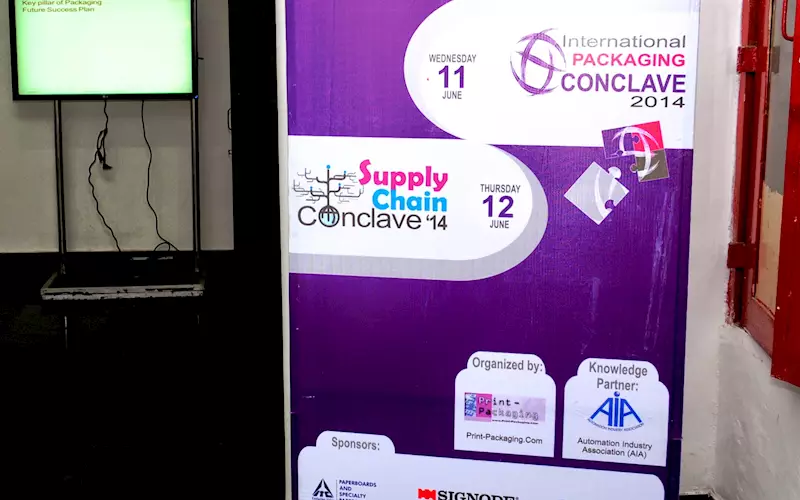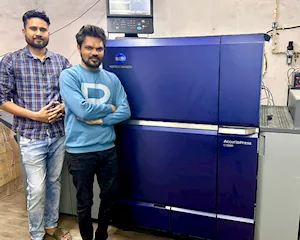Packplus 2014 Conclave Report Roadmap to future: Innovation, automation and anti-counterfeiting
When the crowd gathered at the auditorium at 2pm, braving the scorching Delhi sun outside, that too after a hearty meal, you knew, something special was in store here. The occasion was the two-day International Packaging and Supply Chain Conclave, which was held on June 11 and 12 at Pragati Maidan, New Delhi, as part of PackPlus 2014.
24 Jun 2014 | By Dibyajyoti Sarma
On the first day, the theme was ‘Harmonising packaging design, productivity and secondary packing for better business processes.’ The air was positively rife with anticipation among the various stakeholders of the industry present, especially with the new government at the centre. The same sentiments were expressed by Krishan Gupta, managing director, Organic India, who said what Indian packaging industry needs most is innovation, which is clearly missing. Innovation is the key to clear bottlenecks, Gupta said, adding, “This innovation must come from the grassroots, from the people who works at the factories, because they know what works and what doesn’t.”
Moderating the first panel discussion of the day, on the ‘role of pack design and innovation in the business enterprise, S N Venkataraman, vice president, marketing, ITC – PSPD, quoted Steve Jobs to highlight the essence of design: “Design is not what it looks like and feels like. Design is how it works.” Venkataraman said design innovation is a combination of three key elements, technology, business and human value.
This incidentally led to the very real industry concern about fighting counterfeiting in packaging, which would be a subject of heated discussion among various panelists and the audience on both the days.
Amitabh Kumar, head of packaging, Oriflame India, said innovation is all about taking experience from the past and setting the goal for future. He said the key is sustainability. One of the sustainable materials he mentioned, which pricked attention of the audience was ‘stone paper’, a paper-like product manufactured from calcium carbonate bonded with high-density polyethylene. How, the product is not currently available in India.
Adding to the discussion, Harveer Sahni, managing director, Weldon Celloplast, talked about innovative labeling with the introduction of single liner, linerless labels. In an interesting aside, he also talked about wine labels for the blind, in Braille, which not only offers the basic label info, but also the history of the wine in question. There was a lively discussion on the possibility of getting rid of liners in labeling altogether. There were also discussions on in-mould labeling, pressure-sensitive labeling.
The panels and the audience also discussed the possibility of interactive labels, and also the use of barcode as a means of providing information and also as a means of countering counterfeiting.
The second half of the day’s discussion concentrated on ground realities of automation in packaging. Both the panelists and the audience agreed that lack of standardisation in different aspects of automation is a major pain point.
The theme for the second day was ‘Leveraging supply chain efficiency cost effectively to improve sales and profitability. In his keynote address, Atrash Aman, chief customer officer, TV18 HomeShop Network, elucidated about the added supply chain responsibility in an alternative shopping platform like digital commerce. Saying that e-commerce has still a long way to go, he said it is a $4 billion industry which is growing at the rate of 100%. Since e-commerce is more customer-centric and offers home-delivery of products, it requires a more evolved supply chain, including secondary packaging for product safety, shipment tracking, technology at the last mile, and so on.
In the subsequent discussions, panelists argued that while automation is the key to maintain a cost-effective supply chain, it has not been successful implemented in India. Not only the small and medium manufacturers, even the large ones are labour-intensive. There are automation happening, but in patches. There is no automation system from packaging to dispatch. Again, track and trace solutions are a major concern.
Another concern was the lack of effective cold chain in India, as a result of which, perishable food items are being wasted every day. P L Kaul, managing director, Mariental, said the economic viability of a cold chain, which can help both farmers and consumers, depends on speed. There should be zero inventory in the supply chain. He said pain points for cold chains in India include apathy of corporates and banks, lack of government incentives, lack of infrastructure, including power supply, and a general lack of awareness.
The rest of the day’s discussion concentrated on the means and possibility of fighting counterfeiting. The panelists said counterfeiters are encouraged by the lack of transparency in the supply chain. Saying that there are three aspects of a track and trace system – identify (every unique item of the supply chain), capture (technology like barcode, RFID) and share (master data, transactional data, physical data), the panelists said this traceability should be able to move back and forth.
The experts agreed that while it would be impossible to get rid of counterfeiting completely, precaution at different levels of the supply chain, from innovative packaging to barcoding, can help a great deal. Also, it is important to spread awareness among consumers.
Saying that anti-counterfeiting measures are still evolving in India, Rajiv Dhar, senior international consultant, export packaging, during his concluding remarks, said, “Every business should identify what is good for them.”
S N Venkatraman, Vice President Marketing, ITC Paperboard Specialty Paper Div.















 See All
See All